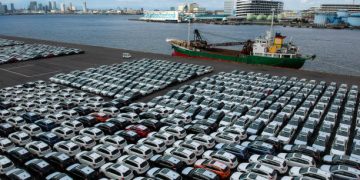Supplychain Report – Japan’s exports posted their sharpest decline in more than four years in July, underscoring the growing strain from tariffs that continue to weigh on global trade flows.
According to data released Wednesday by Japan’s Ministry of Finance, overall exports fell by 2.6 percent year-on-year. The decline was particularly pronounced in shipments to the United States, which dropped by 10.1 percent. Automobiles — a cornerstone of Japan’s industrial output — saw exports plunge by 28.4 percent, while exports of auto parts fell 17.4 percent.
Impact on Japan’s Automobile Industry
The automotive sector remains one of Japan’s most important industries, contributing significantly to both GDP and employment. Companies such as Toyota, Honda, and other manufacturers anchor the country’s global reputation for quality and efficiency. With the sector accounting for about eight percent of Japan’s jobs, declines in exports raise concerns not only for manufacturers but also for the wider economy.
Automobiles have also been at the center of recent trade frictions. Tariffs imposed on Japanese vehicles had initially been set at 27.5 percent, prompting Tokyo to push for negotiations. A new trade agreement concluded last month saw a threatened 25 percent “reciprocal” tariff reduced to 15 percent, with the same lowered rate applied to Japanese cars. However, Japanese officials noted that the reduced tariff on cars has yet to take effect, leaving exporters and auto makers waiting for relief.
Broader Trade Picture
Japan’s experience highlights how tariff measures can ripple through major economies that rely on cross-border trade. As a country with a strong export base, Japan faces heightened exposure to shifts in trade policy. Automobiles, auto parts, electronics, and industrial components are among its most critical exports, and any disruption to these sectors can affect supply chains and production schedules across the globe.
Despite the setback in exports, Japan’s broader economy showed modest resilience in other areas. Official data released earlier this month indicated that the world’s fourth-largest economy grew at an annualized pace of 1.0 percent in the second quarter, slightly above analyst forecasts. Economists suggest that while domestic consumption and investment are providing some support, external demand remains a key vulnerability.
Outlook and Challenges Ahead
Trade experts note that Japan will need to balance short-term challenges from tariff exposure with longer-term strategies to maintain competitiveness. The push to diversify export markets, strengthen regional trade ties within Asia, and continue innovation in sectors such as electric vehicles and advanced manufacturing will likely form part of Tokyo’s response.
At the same time, Japan’s engagement in trade negotiations remains central. Securing favorable terms for key export sectors, particularly automobiles, could mitigate some of the recent pressures. Policymakers are also expected to keep a close watch on domestic industries that are directly affected by shifts in trade policy, ensuring that employment and investment are maintained.
The latest data underscores the delicate balance for Japan: while the economy continues to expand at a measured pace, its heavy reliance on exports means that changes in tariffs can quickly reshape trade flows and test the resilience of its industrial base.
#TariffsAndDuties #JapanExports #GlobalTrade #AutomotiveIndustry #NewsUpdate

















